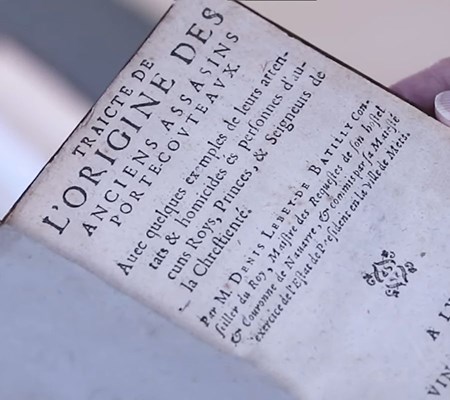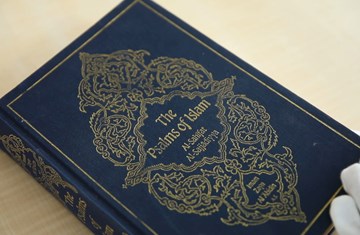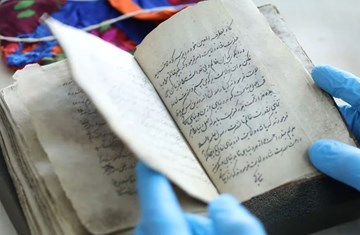Ismailis in History and Myth
This short film features IIS Director Emeritus Dr Farhad Daftary on the topic of myths perpetuated about Ismailis and how modern scholarship is able to challenge them due to manuscripts held in our collection.

Ismailis in History and Myth with Farhad Daftary
This first episode forms part of a new series from the Ismaili Special Collections Unit (ISCU) and the Department of Communications and Development (DCD), which premiered at the Aga Khan Centre in late April. The series will showcase items of historical importance held at The Institute of Ismaili Studies, and highlight their contemporary relevance today.
I am Farhad Daftary, the Director of The Institute of Ismaili Studies.
The Ismailis have, as you know, did actually produce during the various periods of their history very rich literature which for the most part was not available to the outsiders and, as a result, the outsiders actually resorted to their own imaginations or often fabricated evidence about the Ismailis and this is why also some legends and myths were fabricated and put into circulation about Ismaili teachings and practices which led to the misrepresentations of the Ismailis over the centuries. But that situation has now changed in the last few decades because of the availability of the recovery and study of a large number of Ismaili texts which really laid the ground for the modern progress in the field of Ismaili studies and a completely new image has now actually emerged of the history and the teachings of the Ismailis.
Going back to the earlier times, the Ismailis were of course one of the most important Shi‘i Muslim communities but they also represented the most revolutionary wing of Shi‘ism. They did organize a revolutionary movement against the Abbasids, the Sunni rulers of the time because the Ismailis like all other Shi‘i communities believed that the Abbasids, like the Umayyads before them had usurped their rights of ‘Ali, the Prophet’s first cousin and son-in-law and his descendants, the ‘Alids, to the rulership, to the leadership of the Muslim umma. So that was really the religio-political message of the Ismaili revolution: to uproot the Abbasids and to install the Ismaili imam to the caliphate. And this actually happened in the year 909, when the Fatimid state was formed. A state that very soon led to a major empire.
In the course of the 10th century, gradually a ‘black legend' actually emerged which portrayed the Ismailis as a group that aimed to destroy Islam from within and they also came to refute the ‘Alid genealogy of the Fatimid imams. Now these polemical tracts circulated widely and soon were accepted as accurate descriptions of Ismaili teachings and their practices. And a second group of sources produced in the West were really made by the Crusaders and their Western observers. They arrived in the Holy Land in the Near East in the year 1099 and soon seized the city of Jerusalem, their main target. They stayed amongst the Muslims for two hundred years but proximity to Muslims did not really improve their knowledge of Islam and its internal divisions and it was under such circumstances that the Crusaders themselves began to fantasize about the sacred practices of the Ismailis and this led to the creation of the whole genre of myths known as the Assassin legends.
We find the elements of one of these stories which the Ismailis of Syria, the Nizārī Ismailis of Syria or the fidā’īs would use ḥashīsh to be motivated is in this Jewish rabbi’s travelogue, Benjamin of Tudela who passed through Syria at the time and he refers to the Ismailis with the term, Hashishin or Hashishi. It was supposedly because they were accused of using ḥashīsh which was not the case because in the contemporary, anti-Ismaili Muslim sources, we do not find any statement confirming that they used ḥashīsh or the reasons for it. Now this is for instance, the earliest, I would say, independent book written on the Ismailis by a French author, published in 1603. It’s a very rare book; it’s a small book but extremely important in terms of
the history of Ismaili studies. It says "a tract on the origins on the ancient Assassins who were the dagger carriers" written by a French courtier by the name of Denis Lebey de Batilly. Here, the author fantasizes and repeats some of the well-known stories about the Nizārī Ismailis none of which is really rooted in reality. They are just fanciful tales.
The orientalists of the 19th century, starting with Silvestre de Sacy, who died in 1838 and he was the Dean of the European orientalists they started their more scientific study of Islam and its internal divisions on the basis of Muslim manuscripts. And de Sacy, who had a life-long interest in the Druzes and their religion, as background material, he really collected all the information available in those Muslim sources about the early Ismailis and the Fatimids so on, and then he wrote a very long introduction to this which was, in fact, his last publication,
his major work on religion of the Druzes. Here he reiterates the ‘black legend’ of the Sunni polemicists about the Ismailis. And in the same vein, Joseph von Hammer who was an Austrian diplomat orientalist is really credited with having produced the first independent book on the Nizārī Ismailis of the Alamut period but he too like, de Sacy, unwittingly or perhaps wittingly lent his seal of approval to the two categories of sources that was then available to the European orientalists: the ‘black legend’ of the Sunni polemicists and the Assassin legends of the Crusaders and their Western sources.
The Ismailis have as you know did actually produce during the various periods of their history very rich literature which for the most part was not available to the outsiders. And the Ismailis, until recent times, were studied and judged on the
basis of evidence collected or often fabricated by their enemies but it was from 1930s and 40s onwards that, because of access of modern scholars to genuine Ismaili texts, the record really has been speaking for itself and a new image has now
emerged regarding the actual history and teachings and practices of the Ismailis.
And they all point to the rich intellectual diversity and rich intellectual and literary traditions of the Ismailis of different periods. You see amazing pieces of scholarship to the metaphysical worlds dealing with cosmology here for instance we have a dīwān of poetry from the Alamut period; this is a major text known as Haft Bāb or seven chapters from the Alamut period which talks about spiritual declaration of the qiyāmat that was announced at Alamut in 1164. Things really did not improve much until the 1930s when the modern progress in the field began on the basis of the recovery and study of a very large number of genuine Ismaili textual resources and this work was pioneered by the Russian scholar Wladimir Ivanow who had left his native Russia following the October Revolution. He settled down in India where he was commissioned by Sir Sulṭān Muḥammad Shāh, Aga Khan III to formally study the history and the literary heritage and thought of the Ismailis and later on Ivanow, under the patronage the third Aga Khan, founded the Ismaili Society in Bombay with its library of manuscripts and it was during this period, 1930s and 40s, that modern scholarship in the field really took off and increasingly a large number of Ismaili texts came to be edited, published, translated, studied, laying the ground for further progress in the field and that made it possible for instance for a scholar like Marshall Hodgson to publish in 1955 the first scholarly book on the Nizārī Ismailis of the Alamut period, which now replaced the orientalist text of Joseph von Hammer that was published originally in Germany in 1818 and was nothing but a reiteration of the ‘black legend' of the Sunni polemicists and so-called the Assassin legends of the Crusaders and their occidental sources and the progress in the field has proceeded at an astonishing rate and a leading role in that whole domain is now played by the
Institute of Ismaili Studies that was founded in 1977 by His Highness the present Aga Khan and the Institute, through its own research and publications as well as making its textual manuscript resources available to scholars worldwide, is and has been and is playing a leading role in the field of Ismaili studies and is regarded as a point of reference. So had it not been for the existence of this type of literature and its recovery and study in modern times these tales would not have been replaced by actual reliable accounts of Ismaili history and teachings so it’s really the literary record of the community itself that has spoken and has really made it possible for modern scholars to replace fiction by fact and to have an accurate description of what the Ismailis really were all about what sort of history they lived and what sort of intellectual and literary contributions they made to Islamic thought and culture.



